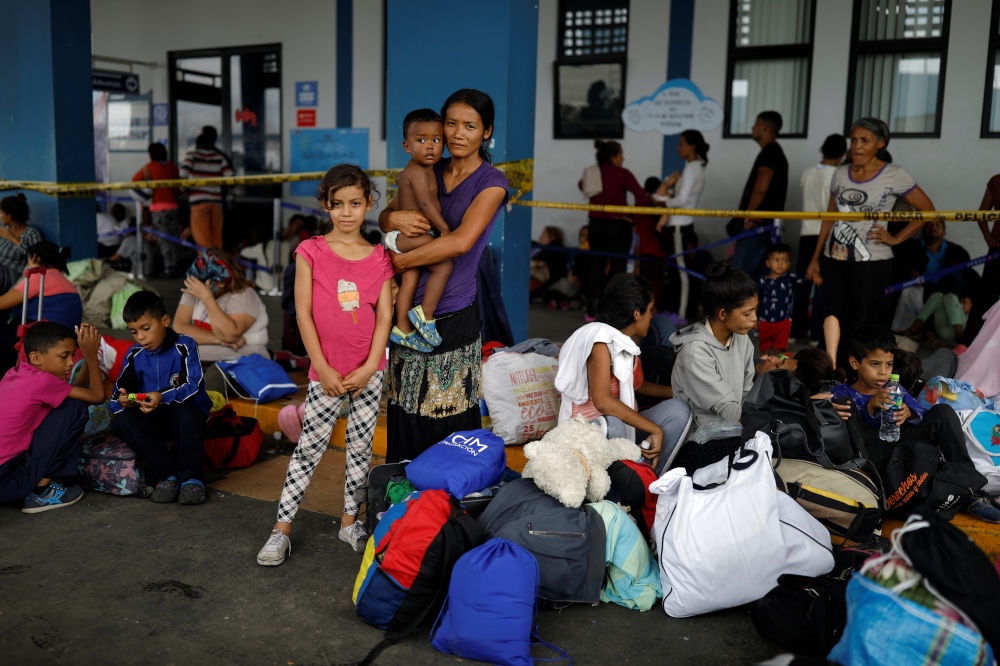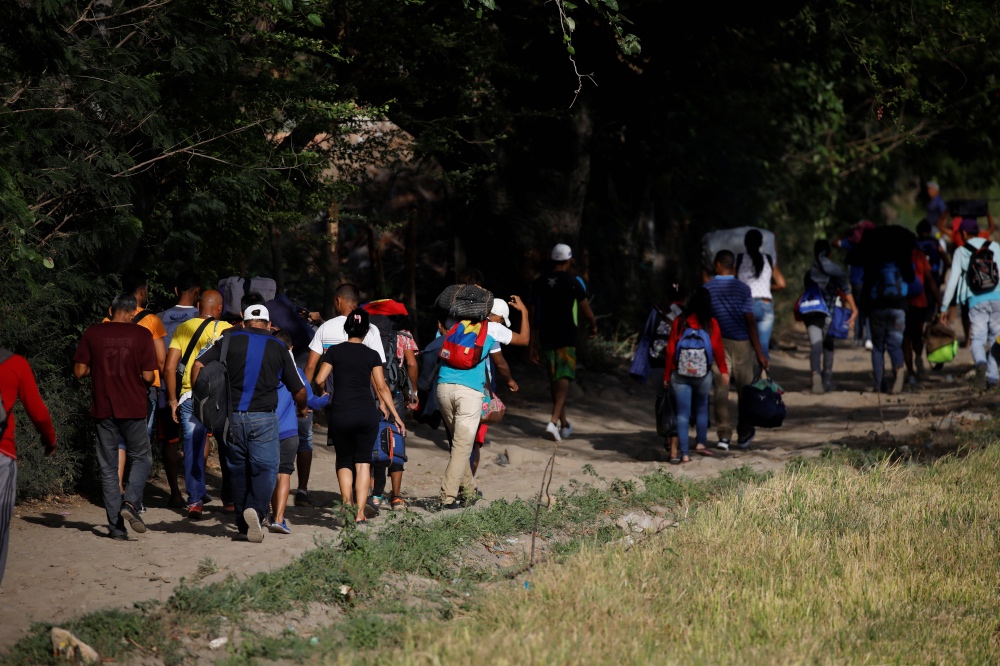
ANASTASIA MOLONEY, of Thomson Reuters Foundation, reports on how nations are imposing new entry restrictions in the midst of South America’s largest migration crisis…
Bogota, Colombia
Thomson Reuters Foundation
Tens of thousands of Venezuelans fleeing turmoil at home face perilous new journeys and risk falling into the hands of criminal gangs after three South American countries clamped down on the mass exodus, the United Nations and experts say.
Venezuela’s economic collapse has unleashed the biggest migratory crisis in recent Latin American history, forcing about one in 10 Venezuelans to leave since 2015.
Another 500,000 are expected to flee over the next six months, bringing the total to five million, the UN estimates.

Venezuelan migrant Maria Valdez, 31, poses for a picture with her children Yoimairy, nine, and Darien, one, while they wait to process their documents at the Ecuadorian-Peruvian border service centre, before they continue their journey, on the outskirts of Tumbes, Peru, on 17th June. Maria Valdez sold her house one year ago to raise the money to pay for her husband to travel to Peru. “My husband went first, I sent him, but I didn’t want to go. But as the money he sent was not enough, we decided to come,” Valdez said. “As soon as I was in Caracas, I wanted to return home, the bus was asking for cash and I did not have it, my daughter started crying and saying that she did not want to go, it was horrible.” “But because of my children I maintained the strength to continue.” PICTURE: Reuters/Carlos Garcia Rawlins
Now their journey to a new life looks fraught with a raft of new dangers: borders stacked with people smugglers, mountain and jungle terrain, plus exploitation by criminal gangs.
To avoid border checks, migrants will likely resort to using hidden footpaths, known as trochas, to escape their homeland.
“The irregular crossings are much more dangerous because of the geography and the landscape and the groups that control them.”
– Jessica Bolter, associate policy analyst at The Migration Policy Institute.
“The irregular crossings are much more dangerous because of the geography and the landscape and the groups that control them,” said Jessica Bolter, associate policy analyst at The Migration Policy Institute, a Washington-based thinktank.
South America has so far won praise for keeping internal borders largely open to Venezuelan migrants and refugees, about three million of whom have settled regionwide.
Yet there are signs the solidarity is waning.
New entry restrictions in Chile, Peru and, most recently, Ecuador have raised fears the open-door policy is ending.
“There definitely has been a move among these countries towards closing off some pathways for Venezuelans,” said Bolter.
“These countries really weren’t prepared,” she said. “It certainly has overwhelmed some of the systems.”
The restrictions – imposed by Peru and Chile in June, and by Ecuador in July – could push migrants onto harsh, risky terrain.
“People who are trying to walk across the bush are putting themselves in danger,” said William Spindler, Latin America spokesman for the UN’s refugee agency, UNHCR.

Venezuelans carry their belongings on an illegal pathway after illegally entering Colombia across the Tachira river close to the Simon Bolivar International bridge in Villa del Rosario, Colombia, on 25th August, 2018. Groups of migrants, mostly young men but also entire families, can be seen illegally crossing the river all day. PICTURE: Reuters/Carlos Garcia Rawlins
Criminal groups – common on the Colombia-Ecuador border and on Colombia’s frontier with Venezuela – target undocumented migrants for labour and sexual exploitation.
“Some of these are criminal networks and armed groups that we know often prey on refugees and migrants,” Spindler said.
“You have also smugglers who operate in these areas. So you are forcing people to go into the hands of smugglers.”
Along Colombia’s northern border with Venezuela, crime gangs charge migrants to cross clandestine paths and avoid officials.
“The more controls that are introduced, the greater the profit margins for migrant-smuggling groups and also greater are the opportunities of criminal groups.”
– Ivan Briscoe, programme director for Latin America and the Caribbean at the International Crisis Group.
“The more controls that are introduced, the greater the profit margins for migrant-smuggling groups and also greater are the opportunities of criminal groups,” said Ivan Briscoe, programme director for Latin America and the Caribbean at the International Crisis Group, a thinktank.
In Ecuador, a decree introduced in July requires a visa for Venezuelans, who had previously only needed identity papers.
Chile and Peru now require Venezuelans to have a passport and visa – documents many do not have or cannot afford.
Venezuelans seeking asylum, however, still can do so without a passport, under international law.
Peru’s President Martin Vizcarra has defended the move, saying while the country has “opened its arms” to more than 800,000 Venezuelans, visas would ensure more control.
On the contrary, said Bolter.
“While some of these governments have kind of justified these measures as ways to create a more safe and orderly migration flow, it’s really just going to do the opposite.
“These flows aren’t stopping, and people are still going to be trying to get into these countries. They are just going to have to put themselves in more danger,” she said.
The catalyst for the clampdown is clear – xenophobia is on the rise, experts say, stoking tensions.
Isolated attacks and hate speech against Venezuelans have been reported in Ecuador, Peru, Colombia and Brazil.
Venezuelan migrants begging at traffic lights, washing car windows and peddling sweets on street corners are now a common sight in many South American cities.
“Local authorities are finding it increasingly difficult to justify doing things for refugees and migrants when the local population also has their own needs,” UNHCR’s Splinder said.
And the clampdown is further fuelled by dwindling hopes for a quick end to the Caracas crisis, as opposition attempts to unseat President Nicolas Maduro appear to have faded.
In January, a power struggle erupted when opposition leader Juan Guaido invoked the constitution to declare a rival presidency. Guaido has since been recognised as the rightful leader by more than 50 nations, including the United States.
“Latin American governments are not seeing the political change they wanted, and therefore the priority now – instead of resolving the political crisis – is once again protecting the borders,” Briscoe said.
“Local authorities are finding it increasingly difficult to justify doing things for refugees and migrants when the local population also has their own needs.”
– William Spindler, Latin America spokesman for UNHCR.
Jan Egeland, secretary general of the Norwegian Refugee Council, said he fears a “domino affect” on border closures.
“When one country starts to be restrictive, others follow because the fear among politicians is that they don’t want to be the last to have borders open and everybody streaming in,” he told the Thomson Reuters Foundation in a phone interview.
The restrictions put most weight on Colombia, experts said.
Thousands of families cross each day into Colombia, home to the highest number of Venezuelan migrants and refugees in Latin America. Some 1.3 million Venezuelans have settled there so far.
Colombia has been praised for its open-door policy.
In 2017, it introduced a two-year permit that let in tens of thousands of Venezuelans, and is poised to pass a new decree letting undocumented migrants apply for temporary work permits.
It also introduced a law this month giving citizenship to children of Venezuelans born in Colombia, with about 24,000 children set to benefit.
“Colombia is leading in the region in terms of their integration of Venezuelans and the measures they are taking,” said Dany Bahar, an expert on global economy and development at the Brookings Institution, a US-based thinktank.
But the big picture remains dark.
“There is no sign that this is going to stop because the situation in Venezuela is not getting better,” UNHCR’s Splinder said. “We will continue to see people leaving, and the figures are just going up literally by the day.”





